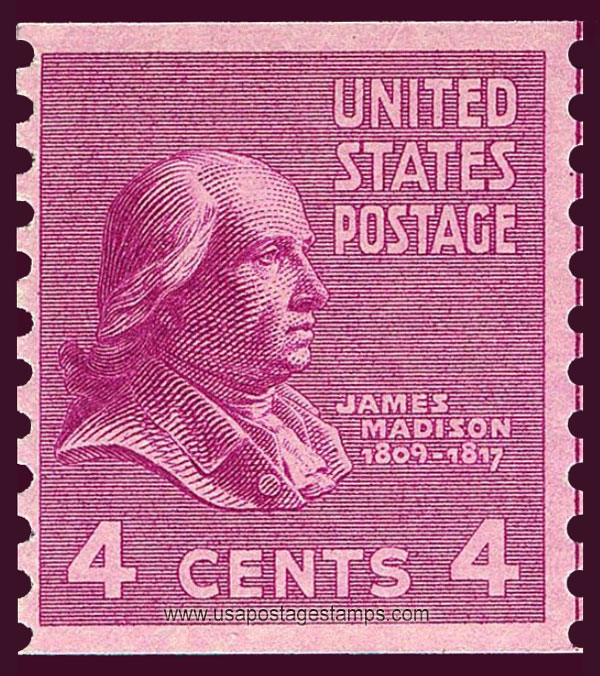US 1939 James Madison (1751-1836) Coil 4c. Scott. 843

Series: Presidential Issue
Issued date: 20-01-1939 (dd/mm/yyyy)
Face value: 4c.
Emission: Definitive (Coil)
Watermark: No Watermark
Catalogue No:-
Scott (USA): 843
Stanley Gibbons (UK): 836
Michel (Germany): 415C
Yvert et Tellier (France): 373Aa
Dimensions (height x width):
25.4mm x 22.2mm
Printer: Bureau of Engraving and Printing
Print Method: Rotary press
Stamp Colors: Red violet
Perforation: Perf 10 Vertically
Themes: Politicians, Famous People, Heads of State
Total print: 41,040,000 (estimate)
Issued date: 20-01-1939 (dd/mm/yyyy)
Face value: 4c.
Emission: Definitive (Coil)
Watermark: No Watermark
Catalogue No:-
Scott (USA): 843
Stanley Gibbons (UK): 836
Michel (Germany): 415C
Yvert et Tellier (France): 373Aa
Dimensions (height x width):
25.4mm x 22.2mm
Printer: Bureau of Engraving and Printing
Print Method: Rotary press
Stamp Colors: Red violet
Perforation: Perf 10 Vertically
Themes: Politicians, Famous People, Heads of State
Total print: 41,040,000 (estimate)
Description:- James Madison Jr. (1751-1836) was an American statesman, diplomat, and Founding Father who served as the fourth President of the United States from 1809 to 1817. He is hailed as the "Father of the Constitution" for his pivotal role in drafting and promoting the Constitution of the United States and the Bill of Rights.
He served as a member of the Virginia House of Delegates and the Continental Congress during and after the American Revolutionary War. Disillusioned by the weak national government established by the Articles of Confederation, he helped organize the Constitutional Convention, which produced a new constitution. Madison's Virginia Plan served as the basis for the Convention's deliberations, and he was one of the most influential individuals at the convention. He became one of the leaders in the movement to ratify the Constitution, and joined Alexander Hamilton and John Jay in writing The Federalist Papers, a series of pro-ratification essays that was one of the most influential works of political science in American history.
Source: en.wikipedia.org/wiki/James_Madison
He served as a member of the Virginia House of Delegates and the Continental Congress during and after the American Revolutionary War. Disillusioned by the weak national government established by the Articles of Confederation, he helped organize the Constitutional Convention, which produced a new constitution. Madison's Virginia Plan served as the basis for the Convention's deliberations, and he was one of the most influential individuals at the convention. He became one of the leaders in the movement to ratify the Constitution, and joined Alexander Hamilton and John Jay in writing The Federalist Papers, a series of pro-ratification essays that was one of the most influential works of political science in American history.
Source: en.wikipedia.org/wiki/James_Madison




